 DATAFOUNTAIN:
MONEY TRANSLATED TO WATER DATAFOUNTAIN:
MONEY TRANSLATED TO WATER
This fountain is connected to money currency rates on the internet. It
is realtime! Refreshed every five seconds. This mobile fountain measures
5x4x3 meters. The relation between money and water is evident.
On our datafountain we display the Yen, Euro and Dollar (¥€$).
Currency rates are closely interconnected; their interdependence is visible
in water. The design of the casing was kept as minimal as possible. The
water is the thing to look at and listen to.
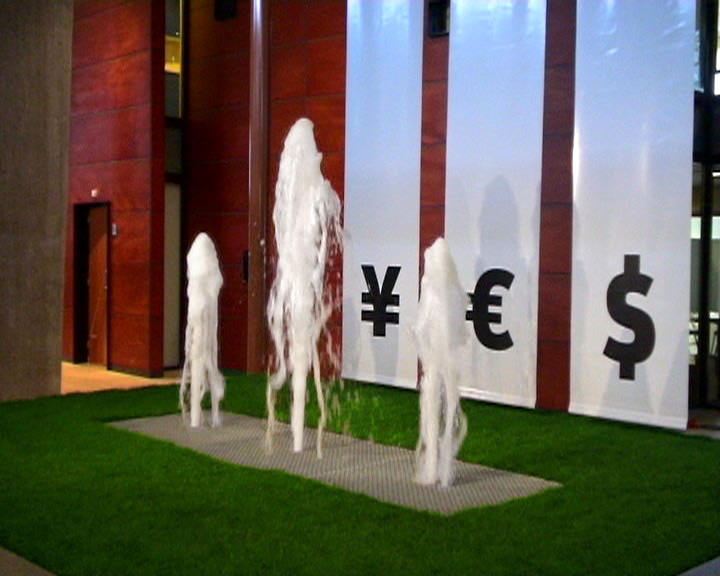
 Datafountain in action, currencyrates refreshed
every five seconds.
Datafountain in action, currencyrates refreshed
every five seconds.
THE BACKGROUND: CALM TECHNOLOGY
With who or what do we have contact the most in our daily life routines?
Our family, our bed pillow, doorknobs maybe? The answer is probably:
Display. We are increasingly surrounded by screens. Think television
sets, mobile phone displays, outdoor led displays, computer screens,
and so on. They are made to inform us, but all too often these busy
flickering noisy screens are also a source of distraction. They demand
our attention, thus creating a nervous and restless environment. |
|
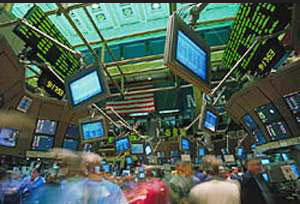
flickery noisy screens, a source of stress
and distraction.
|
 AN
ALTERNATIVE INFORMATION DISPLAY AN
ALTERNATIVE INFORMATION DISPLAY
Is information technology putting us constantly under pressure or could
it also have a calming effect? There are many examples of technologies
that bring us comfort. There is no less technology involved in a comfortable
pair of shoes or in a fine writing pen, than in a computer display. Good
technology isn’t experienced as technology at all [1]. Could this also
be realized in the world of displays?
In natural situations the availability of information is often very well
regulated. Consider the weather as an example. During the day you are
more or less aware of the state of the weather. Before you go out you
explicitly decide if you need an umbrella. Implicitly, you already knew
whether the umbrella question was relevant. Imagine that you were completely
unaware of the weather and had to check a website to find out if you need
an umbrella when you leave your house. Sounds absurd? Still, this is the
model in which information is often presented to us. Some data you continuously
want to have available in your environment. Not in the centre, but rather
at the border of your attention focus.

With natural phenonema, like for instance the
weather, usually explicit as well as implicit data is available.
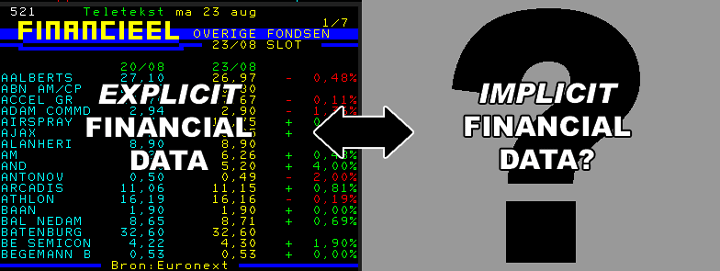
For abstract cultural data, like for instance
financial information, the implicit data is missing!

INFORMATION DECORATION
We are fascinated with fountains, as a phenomenon. You find them on squares,
in gardens, or even indoors on tabletops. Usually a fountain is placed
in a space for aesthetic reasons. Despite of the fact that they are artificially
made, people associate fountains with a sense of naturalness, We find
this intriguing. A fountain is perceived as a source of quietude, not
stress. People experience a fountain as a pleasant object in their environment.
This quality makes it a suitable object for ‘calm’ technology [2].
We propose the term information decoration for displays techniques that aim for a balance between esthetics and informational value.
The goal of the datafountain project is to re-think fountains as information
displays. We equip fountains with a control that can vary the height of
the water jet. Through an Ethernet connection and a frequency modulator
the fountain pumps are controlled. The fountain will function as a calm
display. It can display the latest trafficnews, remote weatherconditions,
train departure times, the amount of people waiting in line at a postoffice,
etc. Or, depending on the context in which the fountain is placed, more
personal data like the amount of email in your inbox or the distance between
yourself and your lover.
 A
FOUNTAIN AS AN ENVIRONMENTAL INFORMATION DISPLAY A
FOUNTAIN AS AN ENVIRONMENTAL INFORMATION DISPLAY
Of course fountains that vary their spouting pattern already exist. The
waterballet is well known. But always, an emotional value of some sort
(often music) is translated into the emotional value of the fountain.
The notion of displaying ‘explicit’ information onto the fountain
is new. The aesthetic value of the fountain display is a huge benefit
in information design. Its presence won’t bother people who are not
interested in the data; information decoration instead of information
push.
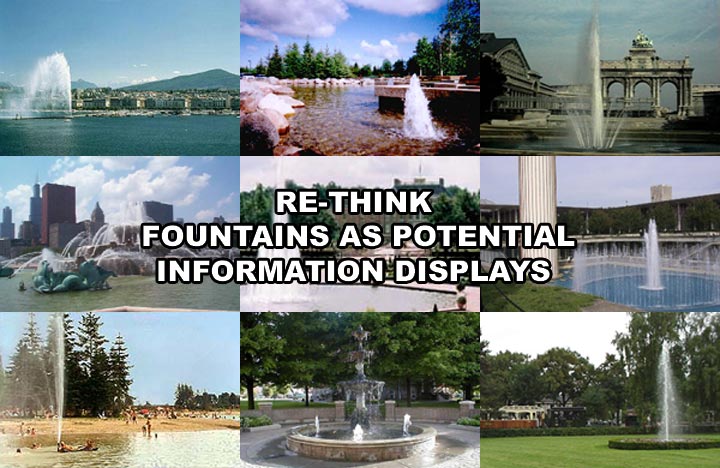
Rethink fountains as potential information displays.
When we see a fountain in public space, we always wonder what its spraying
pattern tells us. It is our future goal to design more contextual datafountains
and also to re-think existing fountains as information displays. Perhaps
in the future, it will be considered rude to place a fountain in public
space that has nothing to say. The information displayed on the fountain
will become part of a discussion about the design of public space. The
context plays an important role in the communicational value; a fountain
in front of a metro station will probably means something different than
a fountain in front of a stock exchange. 

Datafountain in action, currencyrates refreshed
every five seconds.
 MAPPING MONEY CURRENCY RATES TO WATER JETS MAPPING MONEY CURRENCY RATES TO WATER JETS
It was our goal to display a general ‘feeling’ of the relation between the different currencies in the water jets. The currency exchange rates are available with a four digit precision (0.0000). We retrieved them from an online source every five seconds. Within this short time spam, the currency rates alteration is generally very small or zero. The larger changes in the currency rates are a result of many micro fluctuations that happen over time. Through a short user survey we learned the perceived strength of a monetary value is derived from both the long term relation between the currencies, as well as daily fluctuations. At first we tried a linear mapping of the currency rates onto the fountain jets. Due to their smallness, the micro fluctuations became invisible. The result was a fountain that changed slowly over a few days time. This didn’t satisfying us so we decided to try a more sensitive mapping. Now the micro fluctuations were visible but took precedence over the long term development. This resulted in a very noisy and seemingly randomly moving fountain. We wanted to display both the long term development, as well as micro fluctuations to control the height of the fountains. In the final design the basic level of the fountains is derived from the longer term development of the currency rates. This basic level changes slowly over time. In addition to that we exaggerate the micro fluctuations with temporary ‘jumps’ and ‘drops’ of the water jets. The jumps and drops generate the lively expression of the real time trading taking place. For instance, if the Dollar rises on a certain day, the dollar-jet will make many upwards jumps throughout the day. This is perceived as an optimistic (rising) dollar.

THE MAKING OF DATAFOUNTAIN
Below you see pictures of the design and production process of the datafountain,
as well as some evidence of the fun we had during the datafountain production
process.

An early design proposal. |
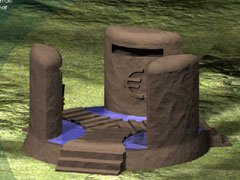
Walkthrough fountain: an early design concept. |

Toying with one of the pumps. |

The embedded hardware and frequency modulators. |

The fountain frame. |
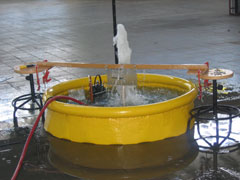
Our first real size working model. |

A look inside. |
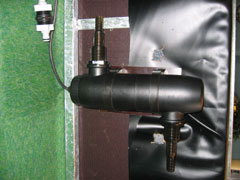
An UV-filters keeps the water legionella free. |
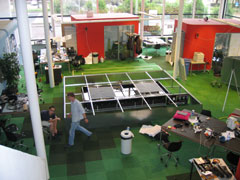
The fountain at the Studio Lab. |
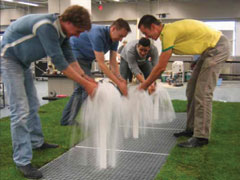
Rik, Roy, Ronald, Koert washing hands in money |
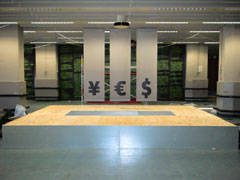
Almost finished. |
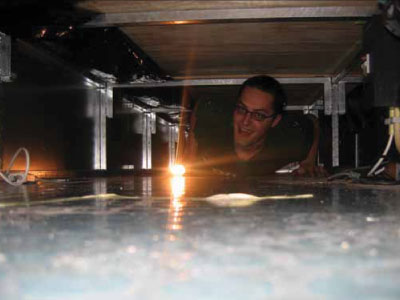
Charles crawling underneath the fountain. |
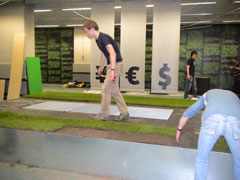
Adding a finishing touch of grass. |
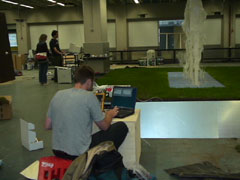
Arian debugging the embedded hardware. |

Left to right: Charles, Benjamin, Rik, Roy, Jan Willem,
Koert. (Ronald and Arian made the picture). |
If you want to learn more about the construction datafountain, you can
view this PDF document. For a movie of our first tiny interactive
fountain (968kb) a movie of the first real size working
model (1.8Mb) and an animation movie of the frame
construction (933kb).
 FOLLOWUP: DATAPLANT, DATAFURNITURE, DATACLIMATE... FOLLOWUP: DATAPLANT, DATAFURNITURE, DATACLIMATE...
The datafountain is just one example of information decoration, one could think of many other applications such as datawallpaper, dataplants, datafurniture, datasoundsand dataclimate that can be implemented.
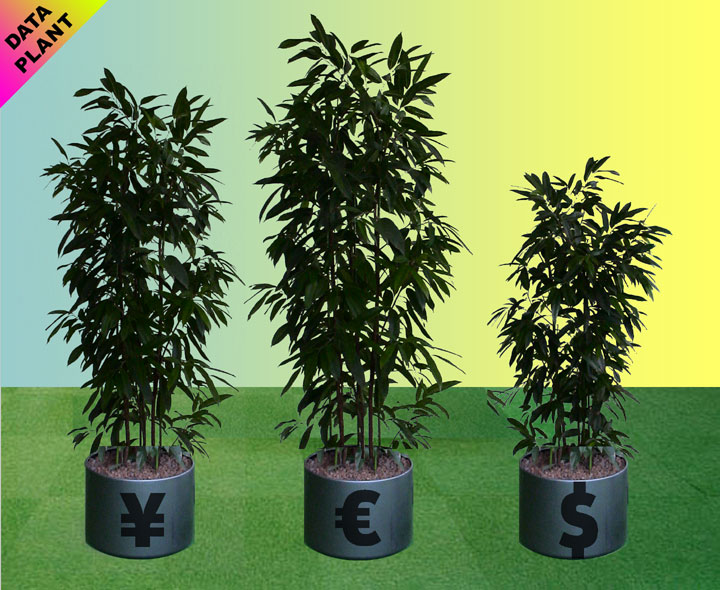
Dataplant in action, currencyrates transformed to growing plants through a digital watering system.
CONCLUSION and FUTURE VISION
In order to understand information decoration we need to look at man's original natural environment. Throughout evolution humans -as well as our predecessors- were forced to scan their surroundings for valuable information. When our brain reached its current state of evolutionary development in Africa 200.000 years ago, there were no media. Every symbol was a thing. The way the environment was interpreted could make a difference of life and death. Nowadays our reality is draped with a layer of symbols and language, but the way in which we experience information is still rooted in this original natural environment [3,4]. |
|
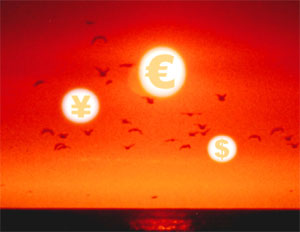
Dataclimate (Ok, this will probably be difficult to implement). |
Currently many digital information appliances force people to retrieve information from sources that are not attuned to our human physical bandwidth at all. Information decoration is an alternative, more calm and open way of data representation. The environment becomes the interface again [5].
 PRESS: DATAFOUNTAIN IN THE MEDIA
PRESS: DATAFOUNTAIN IN THE MEDIA
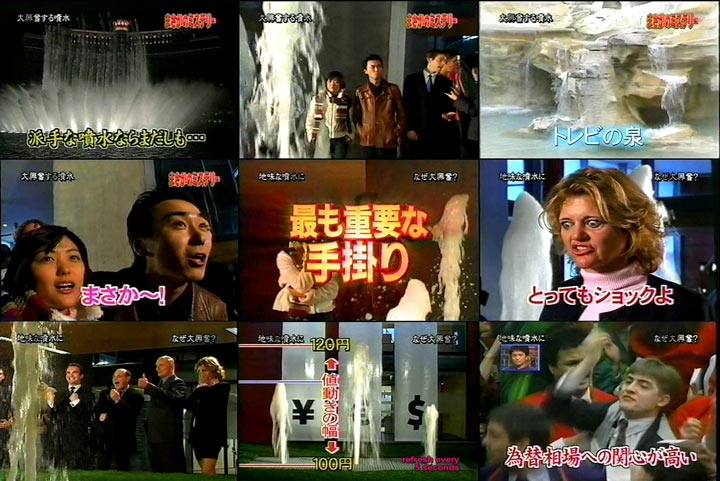
Screenshots from the Japanes TV shooting.
The Japanese television station NTV made a short film about the datafountain in which the viewers had to guess the Amazing Mystery that makes the fountain so special. They didn't guess it, but still the video is kind of entertaining. You can download a fragment of the video (13 mb windows media) there is also a smaller flash version(9mb, swf) .
 What Others say ABOUT THE DATAFOUNTAIN
What Others say ABOUT THE DATAFOUNTAIN
¥€$, we googled ourselves. Below is a selection of things written about the datafountain project.
|
At last, a place where the digital and analog worlds intersect -American Digest
I'm not sure whether embedding digital information in the manifest world is just cool, or if it's useful too. But doing it with fountains is so cool it makes the question irrelevant. -Futuristic
Художник и исследователь из Нидерландов Коэрт ван Менсвурт (Koert van Mensvoort) придумал, как можно использовать фонтан в качестве информационного дисплея — его Datafountain показывает в реальном времени курсы валют -Ua banker
Information Decoration -Angermann
I like this use of the environment to display data, after all, there's only so much I can cram on a screen and concentrate on at the same time, yet there is a lot of data I need to assimilate on a daily basis. Moving some of the data to alternate media can relieve this 'information overload', or at least redistribute it. -Musings from the void
Maak je buren jaloers en installeer een Internet Fontein. Zo'n fontein gaat hoger spuiten zodra bijvoorbeeld je gekochte aandelen het heel erg goed op de beurs doen -Retecool |
Simple, seductive - use fountains to communicate passers-by information about the world. -Terranova
こちらの噴水。
実際の「円」「ドル」「ユーロ」相場とリンクしてて、たとえば円 が上がれば「円の噴水が高く」なって、ドルが下がれば「ドルの噴水が低く」なるって言う面白いもの。
5秒ごとに新しい相場が反映される仕組みになってるそうです。
これは面白い仕掛けですよネ!
しっかし、リンク先にFLASH の動画があるんですけど、よくああやって水をまっすぐに↑にあげることが出来ますよネ。 -10e
De Datafontein in de hal van het Hoofdgebouw trok niet alleen de aandacht van een Japanse televisieploeg, maar ook die van prof.dr. Annelies van Bronswijk. Is er wel nagedacht over het risico van legionellabesmetting, zo vroeg de TU/e-hoogleraar gezondheidstechniek voor het gebouw zich af. -Storm in een datafontein, Cursor 12
We’re also digging on their idea of installing fountains that can indicate how long the lines are inside of post offices.-Engadget
So geeky! I love it! -Modernman |
I like this use of the environment to display data, after all, there's only so much I can cram on a screen and concentrate on at the same time, yet there is a lot of data I need to assimilate on a daily basis. Moving some of the data to alternate media can relieve this 'information overload', or at least redistribute it.
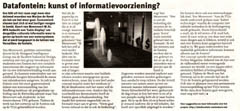
Kunst of informatievoorziening? -Cursor
Evidemment, la diffusion d’information dans le moindre sèche cheveux et le plus petit grille-pain peut sembler discutable du point de vue de la "non-intrusion"... A se demander si pour échapper à l’information on devra un jour allumer le journal télévisé. Bref.
La DataFountain fonctionne plus ou moins sur ce principe : il s’agit d’une fontaine dont le débit se règle sur le cours du Yen, du Dollar et de l’Euro. Une réalisation de Koert van Mensvoort, media-artiste / inventeur / designer prolixe et ultra communicant. Peut-être un jour le Starck du rond-point. -Fluctuat.net |
 Credits Credits
Concept: Koert van Mensvoort MSc MFA
/ Design & Construction: DE212 Industrial Design, Benjamin Voss, Charles
Mignot, Rik Wesselink, Ronald Schipperen, Roy Damgrave, Koert van Mensvoort / Embedded
hardware: ir. Arian van Dorsten, JWA
Systems / Web interface: Drs. Jan Willem Nienhuis / Realtime currencyrates:
MMB / Frame welding: LBW / Fountain Advice:
V.O.F. de Fontijn.
 Realized with support of Fonds BKVB,
TU/e Industrial Design,
Sandberg Institute
 CONTACT CONTACT
Questions? Want to get it in your garden? For inquiries about the datafountain
contact Koert.com.
"In the park next to my home is a fountain. I can see it from
my window. Day in day out it sprays its water in the same boring fashion,
no information in there. I connected this fountain to the cell phone of
my secret lover. The fountain now sprays high when she's in neighborhood
and low when she's far away. It sprays wild when she is receiving many
phone calls. Not spraying at all when her phone is off. People in the
neighborhood think it's just a randomly programmed fountain, but they
are not into ambient information like I am."
 REFERENCES REFERENCES
1. Weiser, M. The computer of the 21st century. Scientific American, pages 94–100, September 1991.
2. Weiser, M., Brown, J. S. Designing calm technology. PowerGrid Journal, Vol. 1, No. 1, 1996.
3. Stephen R. Kellert, "The Biological Basis for Human Values of Nature," in The Biophilia Hypothesis, ed. Kellert and E.O. Wilson (Washington, D.C.: Island Press, 1993), 45-52.
4. Albert Borgmann, Holding On to Reality: The Nature of Information at the Turn of the Millennium, University Of Chicago Press (December 15, 2000), ISBN: 0226066231
5. Koert van Mensvoort, Exploring Next Nature: Nature changes along with us. In Next Nature Pocket, Mensvoort, Gerritzen, Schwarz (Eds.), BIS publishers 2005, ISBN 90 6369 093
 |


















![]()